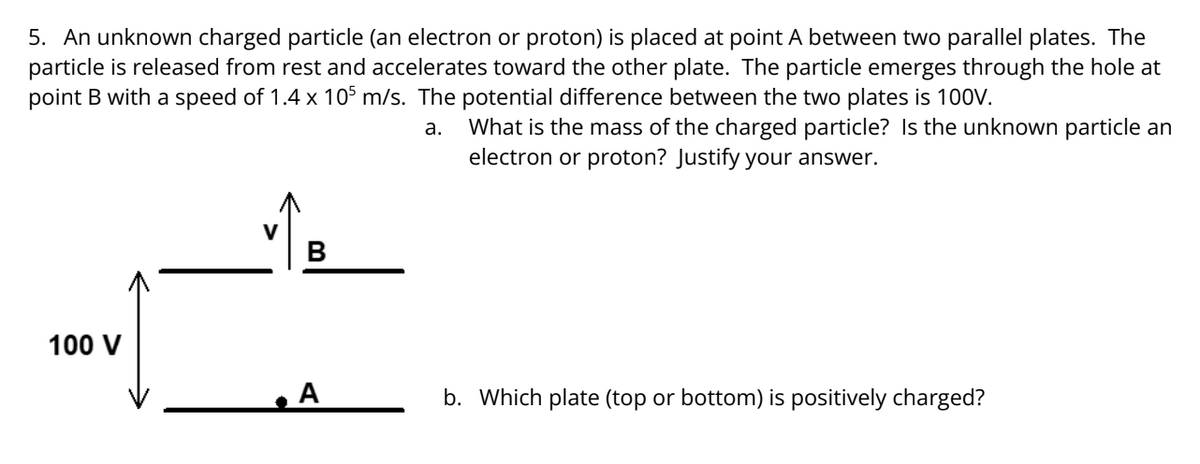5. An unknown charged particle (an electron or proton) is placed at point A between two parallel plates. The particle is released from rest and accelerates toward the other plate. The particle emerges through the hole at point B with a speed of 1.4 x 105 m/s. The potential difference between the two plates is 100V. 100 V B A a. What is the mass of the charged particle? Is the unknown particle an electron or proton? Justify your answer. b. Which plate (top or bottom) is positively charged?
5. An unknown charged particle (an electron or proton) is placed at point A between two parallel plates. The particle is released from rest and accelerates toward the other plate. The particle emerges through the hole at point B with a speed of 1.4 x 105 m/s. The potential difference between the two plates is 100V. 100 V B A a. What is the mass of the charged particle? Is the unknown particle an electron or proton? Justify your answer. b. Which plate (top or bottom) is positively charged?
Physics for Scientists and Engineers: Foundations and Connections
1st Edition
ISBN:9781133939146
Author:Katz, Debora M.
Publisher:Katz, Debora M.
Chapter26: Electric Potential
Section: Chapter Questions
Problem 16PQ: Four charged particles are at rest at the corners of a square (Fig. P26.14). The net charges are q1...
Related questions
Question

Transcribed Image Text:5. An unknown charged particle (an electron or proton) is placed at point A between two parallel plates. The
particle is released from rest and accelerates toward the other plate. The particle emerges through the hole at
point B with a speed of 1.4 x 105 m/s. The potential difference between the two plates is 100V.
a. What is the mass of the charged particle? Is the unknown particle an
electron or proton? Justify your answer.
100 V
A
b. Which plate (top or bottom) is positively charged?
Expert Solution
This question has been solved!
Explore an expertly crafted, step-by-step solution for a thorough understanding of key concepts.
This is a popular solution!
Trending now
This is a popular solution!
Step by step
Solved in 3 steps

Knowledge Booster
Learn more about
Need a deep-dive on the concept behind this application? Look no further. Learn more about this topic, physics and related others by exploring similar questions and additional content below.Recommended textbooks for you

Physics for Scientists and Engineers: Foundations…
Physics
ISBN:
9781133939146
Author:
Katz, Debora M.
Publisher:
Cengage Learning

College Physics
Physics
ISBN:
9781285737027
Author:
Raymond A. Serway, Chris Vuille
Publisher:
Cengage Learning

College Physics
Physics
ISBN:
9781305952300
Author:
Raymond A. Serway, Chris Vuille
Publisher:
Cengage Learning

Physics for Scientists and Engineers: Foundations…
Physics
ISBN:
9781133939146
Author:
Katz, Debora M.
Publisher:
Cengage Learning

College Physics
Physics
ISBN:
9781285737027
Author:
Raymond A. Serway, Chris Vuille
Publisher:
Cengage Learning

College Physics
Physics
ISBN:
9781305952300
Author:
Raymond A. Serway, Chris Vuille
Publisher:
Cengage Learning

Physics for Scientists and Engineers with Modern …
Physics
ISBN:
9781337553292
Author:
Raymond A. Serway, John W. Jewett
Publisher:
Cengage Learning

Physics for Scientists and Engineers
Physics
ISBN:
9781337553278
Author:
Raymond A. Serway, John W. Jewett
Publisher:
Cengage Learning

Principles of Physics: A Calculus-Based Text
Physics
ISBN:
9781133104261
Author:
Raymond A. Serway, John W. Jewett
Publisher:
Cengage Learning